|
The
Douro wine revolution
Part 1: Overview
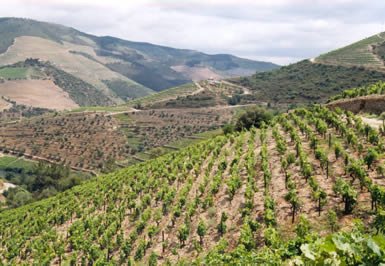
The
view from Niepoort's Quinta de Nápoles, on the River Tedo
The Douro valley, in northern Portugal, is wine geek heaven. I’ve
visited a lot of wine regions, but I was simply stunned by this one.
It was my first visit, and although I’ve read a fair bit about the
region and seen quite a few pretty pictures, this did little to
prepare me for the reality.
|

Old-style walled terracing on
one of the steep slopes
|
n |
The
scenery is spectacular. As far as the eye can see, the
mountainous terrain is covered with countour-line-like terraces.
The scale is impressive, too. There’s just so much of it. I
don’t think I’m exaggerating too much when I say that the
Douro is one of the wonders of the world.
Then there’s the soil. The ‘terroir’,
if you like that term, is just about perfect for growing quality
wine grapes. It’s schist, with a bit of granite here and
there. It doesn’t look promising for growing anything, but
vines flourish in these conditions. The poor soil encourages
them to sink their roots deep, where they find a steady but
stingy water supply and divert their energies to grape
production. |
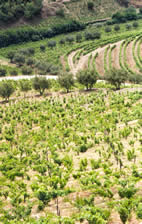 The
climate is continental, very hot and desert-dry in the summer;
cold and wet in the winter. One of the fascinating aspects of
the region, though, are the small-scale variations between the
different vineyard sites. With each twist and turn of the
various valleys, and from the top of the slope to the bottom,
conditions can be remarkably different. For example, down by
the river the grapes will ripen a lot faster than those at the
higher vineyards, which may be 400–500 metres higher up. The
climate is continental, very hot and desert-dry in the summer;
cold and wet in the winter. One of the fascinating aspects of
the region, though, are the small-scale variations between the
different vineyard sites. With each twist and turn of the
various valleys, and from the top of the slope to the bottom,
conditions can be remarkably different. For example, down by
the river the grapes will ripen a lot faster than those at the
higher vineyards, which may be 400–500 metres higher up.
The region is split into three
quite different areas. Coming from Porto, first you hit the
Baixo Corgo, the coolest and wettest of the three. With just
over 14 000 ha, this makes up one third of the region. Next is
the most important zone, the Cima Corgo. Roughly centred
around the town of Pinhão, its 19 000 ha make up 45% of the
Douro. Finally, we have the Douro Superior, much further up towards the
Spanish border, and occupying 8700 ha (20% of the region). This is the
hottest, driest region of the three.
|
n |
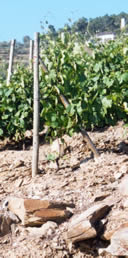
'terroir'
|
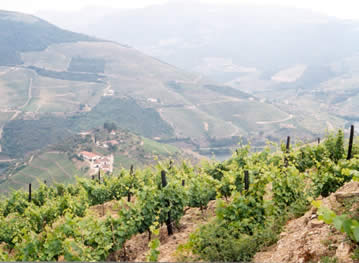
Looking down over Quinta do
Crasto |
n |
If the Douro wasn’t already a wine region, no one would think
today about putting vineyards here. Far too difficult. I has taken a
miracle of agricultural engineering to plant vines here at all. Most
of the slopes are so steep that the only way to grow anything is by
creating terraces.
Terracing the old-fashioned way involved the painstaking
construction of dry stone walls to support the banks of soil. Dynamite
was (and still is) often needed to clear the way. The modern method is
more brute force, with wide terraces being carved out of the hillside
by bulldozers.
|
It’s currently boom time in the Douro, so there are lots of
bulldozers around. Land prices are currently high. Everywhere you look
new vineyards are being planted (at great cost), and old ones
renovated.
|
What of the wines? The recent history of the Douro is dominated by
the Port trade. There are still some 85 000 growers here (a staggering
number). While table wines have always been made in the region, until
very recently almost all the best grapes were destined for Port
production. These growers would either sell their grapes, or make the
port wine themselves. The traditional method is to dump the grapes in
large shallow stone troughs (known as ‘lagares’), into which would
hop an assortment of locals who would then tread the grapes repeatedly
over the next couple of days.
|
n |
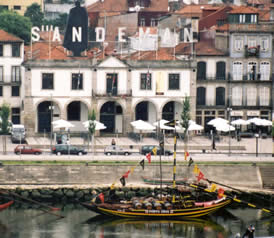
Rabelos outside the Port lodges at
Vila Nova de Gaia |
At a certain point in fermentation,
while there was still quite a lot of grape sugar left, brandy would be
added. This stops the fermentation process leaving a sweet, strong
wine that would then be put into cask to begin the ageing process. The
major port companies then sent out teams of expert tasters, who would
determine the quality and decide the destination of the wines: perhaps
LBV, tawny, ruby, or in rare cases in very good vintages, vintage port
itself.
Before the advent of air conditioning, it was then important to
transport the wines down river to Porto before the onset of summer,
where they were aged in the port lodges of Vila Nova de Gaia. Any
wines left in cask over summer in the Douro would be at risk of baking
in the heat. It was a fairly perilous journey (these days the Douro is
dammed, and is much gentler: gone are the rapids), made then in
special boats called ‘rabelos’.
Overview continued on next page...
Back to top
17/06/02
Conflicts of
interest: in line with good journalistic practice, I need to declare
here that my travel and accommodation were paid for by Dirk Niepoort.
I'm grateful to Dirk for his generosity, but I have not allowed this
to affect my assessments.
|

